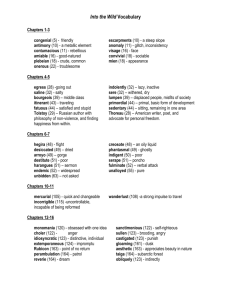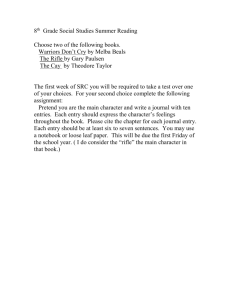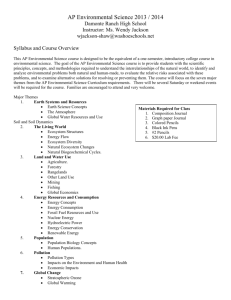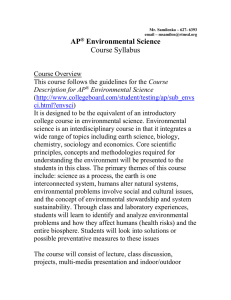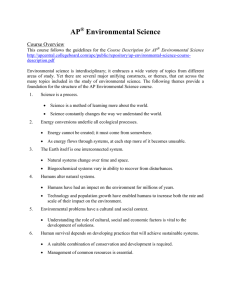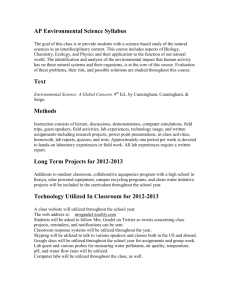AP Environmental Science
advertisement
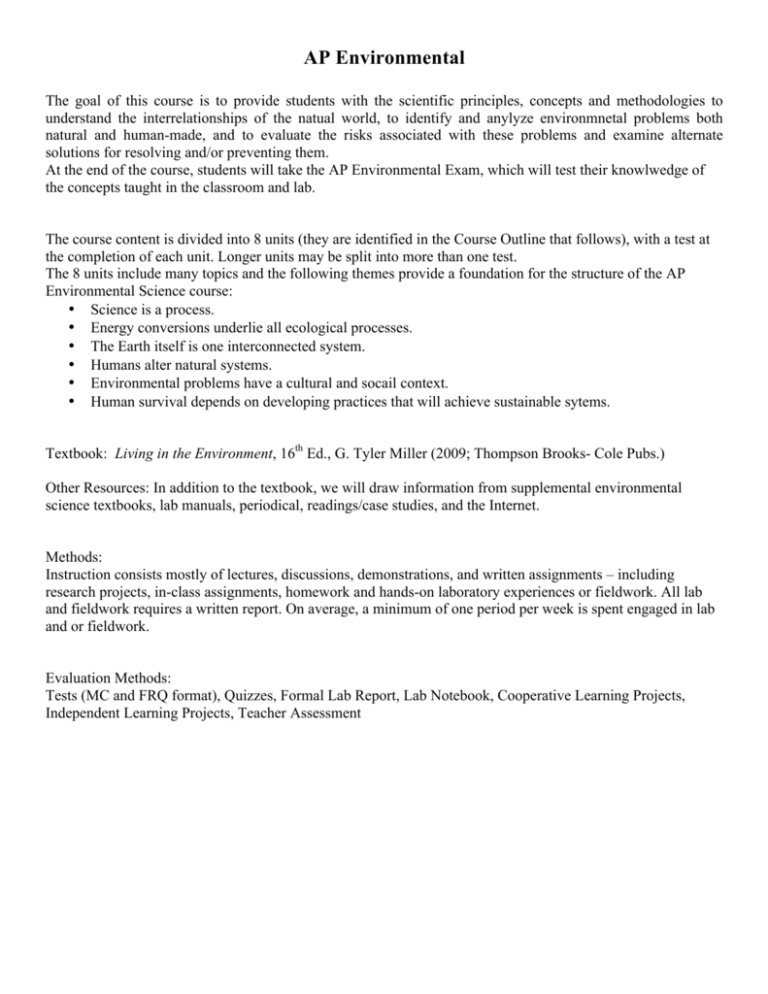
AP Environmental The goal of this course is to provide students with the scientific principles, concepts and methodologies to understand the interrelationships of the natual world, to identify and anylyze environmnetal problems both natural and human-made, and to evaluate the risks associated with these problems and examine alternate solutions for resolving and/or preventing them. At the end of the course, students will take the AP Environmental Exam, which will test their knowlwedge of the concepts taught in the classroom and lab. The course content is divided into 8 units (they are identified in the Course Outline that follows), with a test at the completion of each unit. Longer units may be split into more than one test. The 8 units include many topics and the following themes provide a foundation for the structure of the AP Environmental Science course: • Science is a process. • Energy conversions underlie all ecological processes. • The Earth itself is one interconnected system. • Humans alter natural systems. • Environmental problems have a cultural and socail context. • Human survival depends on developing practices that will achieve sustainable sytems. Textbook: Living in the Environment, 16th Ed., G. Tyler Miller (2009; Thompson Brooks- Cole Pubs.) Other Resources: In addition to the textbook, we will draw information from supplemental environmental science textbooks, lab manuals, periodical, readings/case studies, and the Internet. Methods: Instruction consists mostly of lectures, discussions, demonstrations, and written assignments – including research projects, in-class assignments, homework and hands-on laboratory experiences or fieldwork. All lab and fieldwork requires a written report. On average, a minimum of one period per week is spent engaged in lab and or fieldwork. Evaluation Methods: Tests (MC and FRQ format), Quizzes, Formal Lab Report, Lab Notebook, Cooperative Learning Projects, Independent Learning Projects, Teacher Assessment AP ENVIRONMENTAL COURSE OUTLINE Unit 1: Population (Chapters 5&6) (4 weeks) A. Population Biology Concepts B. Human Population Unit 2: The Living World (Chapters 3-5, 7-11) (4 weeks) A. Ecosystem Structure B. Energy Flow C. Ecosystem Diversity D. Loss of Biodiversity E. Natural Ecosystem Change F. Biogeochemical Cycles Unit 3: Earth Science Concepts (Chapters 12 &14) (2 weeks) A. Soil B. Soil Dynamics Unit 4: Earth Systems and Resources (Chapters 3, 7 &13) (2 weeks) A. The Atmosphere B. Global Water Resource and Use Unit 5: Land and Water Use (Chapters 10 & 12) (3 weeks) A. Agriculture and Fishing B. Food Production C. Forestry D. Rangelands Unit 6: Energy Resource and Consumption (Chapters 14-16) (6 weeks) A. Energy Concepts B. Energy Consumption C. Fossil Fuel Resources and Use D. Nuclear Energy E. Hydroelectric Power F. Energy Conservation G. Renewable Energy Unit 7: Pollution (Chapters 12, 17, 18, 20, 21, 23 &24) (6 weeks) A. Soil Pollution B. Solid/Hazardous Waste C. Air D. Water E. Human Health F. Economic Impacts Unit 8: Global Change (Chapter 19) (3 weeks) A. Stratospheric Ozone B. Global Warming



